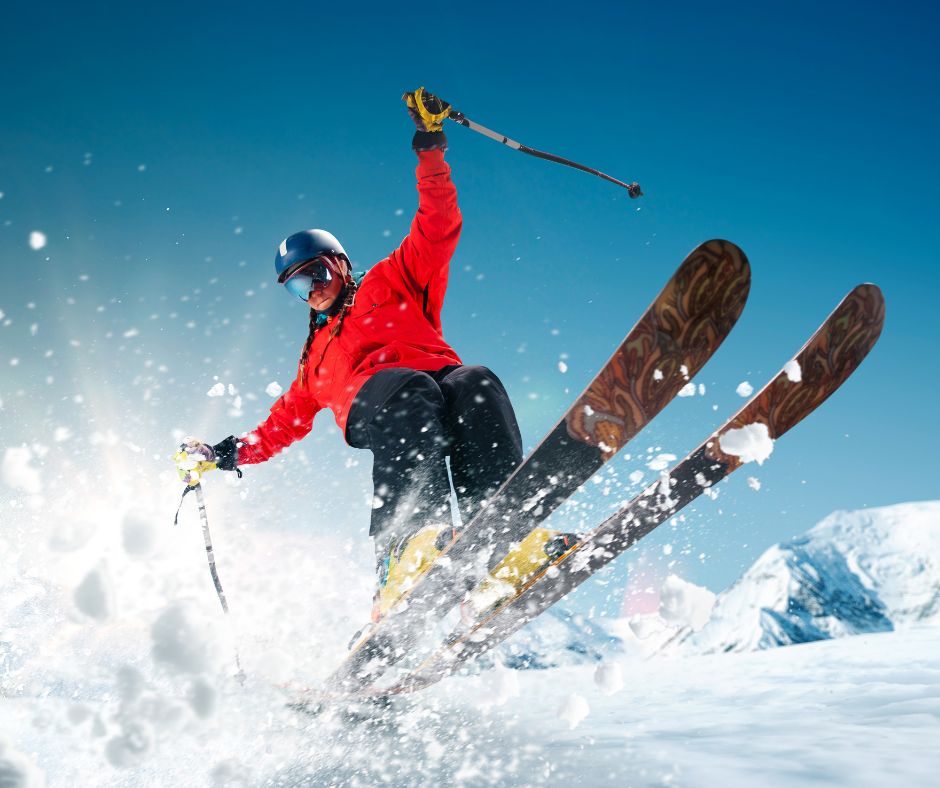At this time of year, many in Western PA turn their thoughts toward the snow and to skiing or snowboarding. However, the ski season should start weeks before the skiing. Here is some useful information to help you have a fun and safe ski season.
The best way to minimize injury risk is to begin a pre conditioning program several weeks before hitting the slopes.
Pre conditioning exercises: Focus on the legs and the core.
- Legs: Squats or sit to stands, side steps, lunges, step ups, single leg stands.
- Squats: Stand with equal weight on both feet. Stance should be shoulder width apart or slightly wider. With eyes looking forward, lower into a squat, as though you were going to sit down into a chair. 1/4 to 1/2 range is fine. Base the squat depth on what your body can manage. Perform 2 sets of 10 repetitions.
- Sit to stand: As described in the title. Sit in a chair and move to a standing position. Make sure you lean forward (nose over your toes). Raise up and lower down with control. Perform 2 sets of 10.
- Side steps: Stand in a comfortable position with knees “soft”. Keep toes pointed forward and side step right/left. Set a timer for 1 minute and repeat twice.
- Lunges: Stand comfortably with feet shoulder width apart. Step out with one leg and flex front knee to comfortable depth. Return to start. Repeat 10 x on each side.
- Step ups: Begin at base of a step. Place one foot onto step and step up to the same step with the other foot. Keep the initial foot on step and lower down the other foot. Repeat 10 to 20 times on one side and then switch.
- Single leg stands: Work on balance by standing on one leg for as many seconds as possible. Switch sides and perform for 2 minutes.
- Core: Planks, Bird Dog, Russian Twists
- Single leg stands: Work on balance by standing on one leg for as many seconds as possible. Switch sides and perform for 2 minutes.
- Planks: Begin kneeling, sitting on heels. Place hands on floor in front of you so on all fours. Walk your hands forward and straighten legs into a straight plank. Keep belly button pulled in and make sure you breathe. Hold for 10 to 30 seconds. Repeat 10 times.
- Bird dog: Begin on all 4’s, with arms under shoulders. Stretch one arm out, and opposite leg at the same time, until parallel to the floor. Hold briefly and return to start. Repeat 10 x on each side.
- Russian Twists: Sit on ground or pad, knees and hips slightly bent. Heels on the ground. Lean trunk backwards with spine neutral. Twist to side, back and forth. Repeat 2 x 10.
- Note: As with every exercise program, the sets and reps can be adjusted based on your fitness level and overall goals.
Here are some basic exercises for ski day! You can always add more but this is a nice base.
- Lower body warm ups
- Front to back leg swings: Stand holding onto counter or a chair and swing one leg back and forth, from hip (like a pendulum). 20 repetitions on each side. Repeat with other side.
- Horizontal leg swings: Stand holding onto counter or a chair and swing one leg back and forth from hip. 20 repetitions on each side. Repeat with other side.
- Butt kicks: try to kick back behind you as high up to your butt as possible. Repeat 20 to 30 times.
- Upper body warm ups
- Shoulder rolls: 20 times.
- Arm circles: 20 times each way.
- Arm jumping jacks: 20 times.
On ski days, make sure you dress appropriately for the current weather conditions. Don’t forget to stay hydrated with the right kind of fluids. In the cold, dry air, you may not notice the dehydration until you are not feeling well. Remember, most injuries happen with increased fatigue. If you are not in great shape, make sure you take breaks. Also, consider backing down to the easier slopes at the end of the day.
One notorious injury related to skiing that can be significantly decreased with simple education is a sprain or tear of the ulnar collateral ligament. The ulnar collateral ligament, located in the thumb, can be injured from improperly holding ski poles. To minimize the risk of this injury, make sure you strap your ski poles on correctly. To do this, make sure you put your entire hand through the strap so that the strap is hanging from your wrist. If you just hold the strap in your hand and have a fall, the strap can get caught on your thumb and tear the ligament. This can make for a painful day, and possible need for medical attention.

